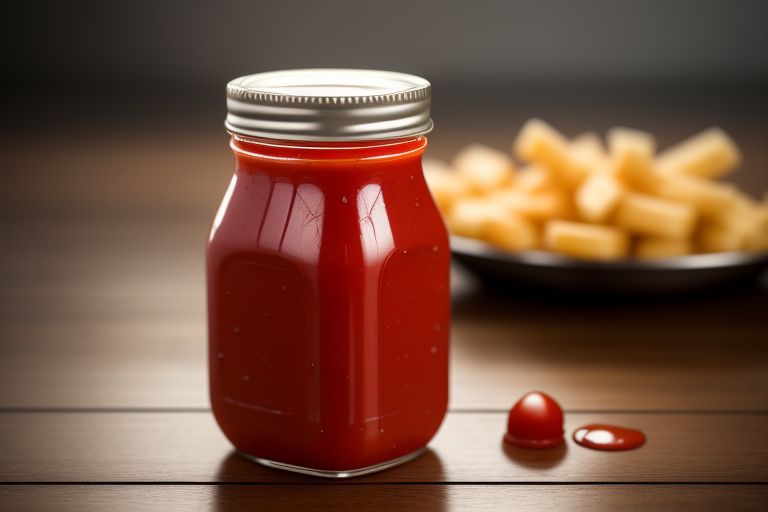Contents
Introduction
In recent years, the culinary landscape has witnessed a resurgence of interest in artisanal and homemade products, with condiments taking center stage in this movement. “Ketchup Reinvented: The Art of Crafting Homemade Condiments” delves into the transformative journey of one of the most beloved sauces in the world.
Traditionally associated with mass-produced versions that dominate supermarket shelves, ketchup is being reimagined by home cooks and gourmet chefs alike who seek to elevate this staple by embracing fresh, high-quality ingredients and unique flavor profiles.
This article explores the nuances of crafting homemade ketchup, offering insights into the balance of sweetness, acidity, and spice that define its character. Beyond the classic tomato base, we will highlight innovative variations that incorporate seasonal produce, herbs, and international influences, encouraging culinary creativity in the kitchen. By understanding the methods and techniques behind homemade condiments, readers will not only enhance their culinary repertoire but also reconnect with the art of cooking.
Join us as we embark on a flavorful journey, transforming a simple condiment into a canvas for personal expression and gastronomic delight. Discover how homemade ketchup can elevate your meals and inspire a new wave of condiment craftsmanship.
History of Ketchup
Ketchup has a rich and fascinating history that dates back centuries. Its origins can be traced to the 17th century in Southeast Asia, where a fermented fish sauce called “kecap” was used as a condiment. This sauce eventually made its way to China, where it was adapted and became known as “kê-tsiap.”
European explorers encountered this flavorful sauce and sought to replicate it, leading to various attempts at creating similar condiments. By the 18th century, recipes for tomato-based sauces began to emerge, particularly in the United States, where tomatoes were cultivated and integrated into the traditional ketchup recipe.
In the 19th century, the commercial production of ketchup took off, with Heinz being one of the first companies to mass-produce the condiment in 1876. Their recipe, which included tomatoes, vinegar, sugar, and spices, quickly gained popularity and became a staple in households across America. Over the years, ketchup evolved, with various regional variations emerging, but the classic tomato ketchup remained a beloved favorite.
Today, ketchup is an iconic condiment enjoyed worldwide, often paired with fries, burgers, and countless other dishes. Its journey from a fermented fish sauce to the ubiquitous tomato-based condiment we know today is a testament to its adaptability and enduring appeal.
Homemade Ketchup Recipe
Making ketchup at home is a simple yet rewarding process that allows you to customize flavors to your liking. Let’s begin.

Ingredients:
1/2 cup water
5 pitted dates
6 tsp apple cider vinegar
1 tsp mustard
6 ox tomato paste
1/2 tsp cumin
1/4 tsp cinnamon
1/8 tsp all spice
1/2 tsp salt
Direction
Begin by gathering your ingredients, which typically include ripe tomatoes, vinegar, sugar, salt, and various spices such as onion powder, garlic powder, and ground allspice.
Start by washing and chopping the tomatoes, then cook them down in a large pot over medium heat until they soften, releasing their juices. Once cooked, blend the tomatoes until smooth.
Strain the mixture through a fine sieve to eliminate seeds and skins for a velvety texture. Return the strained tomato puree to the pot and add the vinegar, sugar, and spices. Simmer the mixture on low heat, stirring occasionally, until it thickens to your desired consistency, which usually takes about 30 to 60 minutes.
Taste the ketchup and adjust the seasonings if needed, adding more sugar for sweetness or vinegar for tanginess.
Once the ketchup has achieved the perfect balance of flavors and thickness, allow it to cool before transferring it to sterilized jars or bottles for storage.
Homemade ketchup can be refrigerated for several weeks, providing a fresh, preservative-free alternative to store-bought versions.
Print this recipe

Homemade Ketchup
Ingredients
- ½ cup water
- 2 pitted dates
- 6 tsp. apple cider vinegar
- 1 tsp mustard6 ox tomato paste
- ½ tsp. cumin
- ¼ tsp. cinnamon
- ⅛ tsp. all spice
- ½ tsp. salt
Instructions
- Begin by gathering your ingredients, which typically include ripe tomatoes, vinegar, sugar, salt, and various spices such as onion powder, garlic powder, and ground allspice.
- Start by washing and chopping the tomatoes, then cook them down in a large pot over medium heat until they soften, releasing their juices. Once cooked, blend the tomatoes until smooth.
- Strain the mixture through a fine sieve to eliminate seeds and skins for a velvety texture. Return the strained tomato puree to the pot and add the vinegar, sugar, and spices. Simmer the mixture on low heat, stirring occasionally, until it thickens to your desired consistency, which usually takes about 30 to 60 minutes.
- Taste the ketchup and adjust the seasonings if needed, adding more sugar for sweetness or vinegar for tanginess.
- Once the ketchup has achieved the perfect balance of flavors and thickness, allow it to cool before transferring it to sterilized jars or bottles for storage.
- Homemade ketchup can be refrigerated for several weeks, providing a fresh, preservative-free alternative to store-bought versions.
The Many Uses of Ketchup
Ketchup is a versatile condiment that transcends its traditional role as a topping for fries and burgers. Its sweet and tangy flavor profile makes it an ideal ingredient in a variety of dishes. Many people use ketchup as a base for marinades and sauces, enhancing grilled meats and roasted vegetables alike.

In addition, ketchup is a popular choice for incorporating into recipes for dishes like meatloaf, baked beans, and barbecue sauce, adding richness and complexity. In creative cooking, it can be used in salad dressings or as a dip for appetizers, showcasing its adaptability. Whether as an ingredient, a condiment, or a cleaning solution, ketchup proves to be a staple in both kitchens and households around the world. Its ability to complement a wide range of flavors and dishes underscores its status as a beloved pantry essential.

Ketchup in the Caribbean and Latin America
Ketchup has gained remarkable popularity in the Caribbean and Latin America, transcending its origins as a simple condiment to become a staple in many households and restaurants across the region. This widespread affection for ketchup can be attributed to its versatility, as it complements a variety of local dishes, from fried plantains to grilled meats to rice dishes, such a Paleau.
In many Caribbean countries, ketchup is not merely a side sauce; it is often used as an ingredient in marinades and dressings, adding a tangy sweetness that enhances the flavor profile of traditional meals. Additionally, the rise of fast food culture has further solidified ketchup’s status, making it a ubiquitous accompaniment to burgers, fries, and other popular items.
The local adaptation of ketchup, often infused with spices and flavors unique to the region, has also contributed to its appeal, allowing it to blend seamlessly into the culinary landscape. As a result, ketchup has become more than just a condiment; it is a cultural phenomenon that reflects the diverse tastes and preferences of Caribbean and Latin American cuisines.
In conclusion, crafting your own homemade ketchup is more than just a culinary experiment; it’s a delicious journey into the heart of flavor and creativity. By blending fresh ingredients and experimenting with spices, you transform a humble condiment into a culinary masterpiece that reflects your personal taste. So, the next time you reach for that store-bought bottle, remember that the art of ketchup-making is at your fingertips. Embrace the joy of crafting your own sauces, and let your taste buds guide you toward a world of endless possibilities. After all, in the realm of condiments, the only limit is your imagination!
